Fig. 5. Improvised Vacuum, by Jesse Howard for OpenStructures

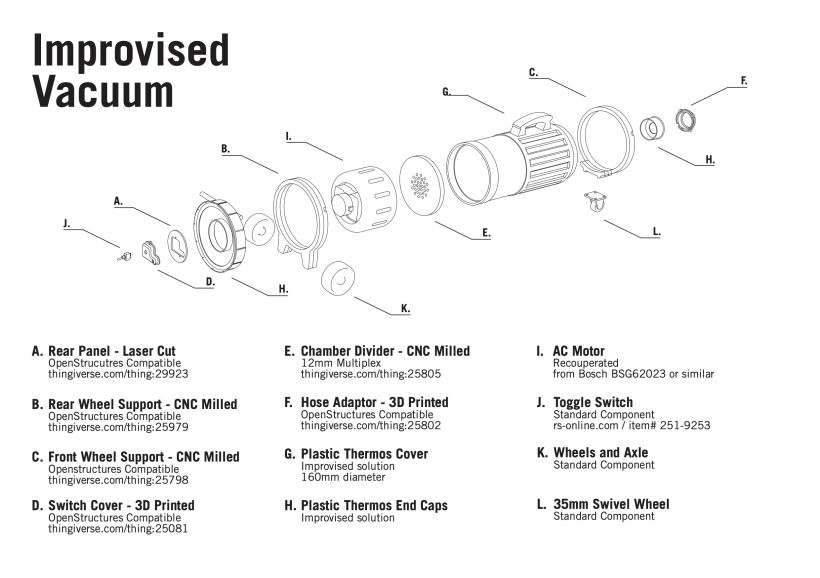

A red plastic cylinder bracketed in a wooden frame on skate wheels, attached by a hose to a brush with matching red bristles [fig. 5]. An assemblage of laser-cut, CNC-milled or 3D-printed pieces, together with some standard industrial components and a recuperated motor. This short description of an Improvised Vacuum modestly indicates that it is built around a plastic thermos – one may think of bricolage, creative reuse or “IKEA hacks”, and proof that users can be smarter than designers by repurposing their products in entirely unexpected ways. Without context, it would appear to be a one-off, quirky, idiosyncratic designer object; a provocative piece illustrating DIY that is destined for exhibitions, and never to be used, let alone to enter production. As part of the OpenStructures project however, it stands as evidence of the alternative value circuits that some designers already inhabit. By extension, it hints at how mundane, household items would be designed and produced in an alternate universe, perhaps one in which exchange relations are absent.



Transparent Toaster comes in two sizes, regular and “industrial”, stretched along its length the way a limousine is to an ordinary car [fig. 6]. Perhaps this is meant to suggest an infinite possibility of sizes, a steel mesh that can be as long as the number of bread slices to be toasted concurrently. It has no sophisticated spring mechanism, and no timer to ensure perfect crispness; it is a structurally transparent toaster stripped to the bare bones. It comes with a single-page assembly guide where every piece is referenced and sourced, as off-the-shelf components, OpenStructures-compatible parts and a repurposed heating element. What does the physical transparency of the object reveal about the aesthetics and ethics of its material cycles? What does the materiality of objects tell about the conditions of their production?

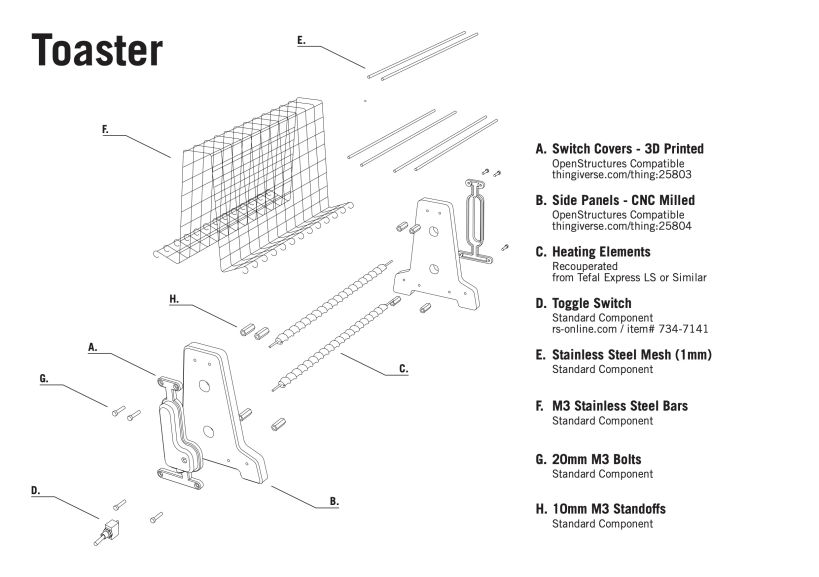
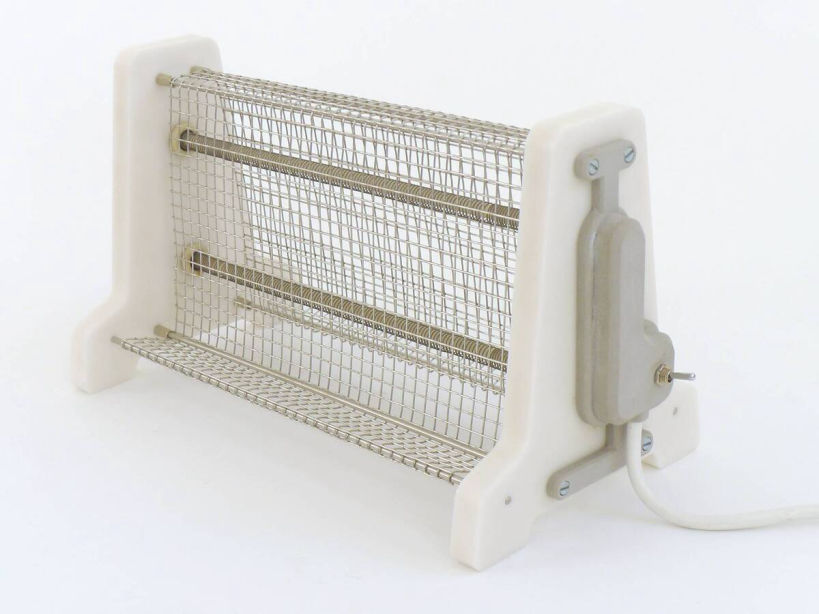
The OS WaterBoiler is not your usual plastic moulded case kettle that could once be bought dirt-cheap from the nearest big-box retail store, before breaking down or melting away, never to be repaired nor recycled. Neither is it a special edition reissue of a Bauhaus design, nor a postmodern monument made for the Italian brand Alessi, targeting the tastes and budgets of those looking for more than the ordinary plastic kettle. Instead, the OS WaterBoiler is a research project on the material flows that create assemblages of parts and components. It has multiple iterations that are a result of different processes of production – the version destined for single-unit limited production has parts that are either self-produced or bought at a local retail, whereas a 100- or 1000-unit production scenario mixes local production with internationally supplied components [fig. 7]. Against the inevitability of the standard plastic kettle for the mass market, it hypothetically activates a multiplicity of alternatives that are adaptable to the local economy. Can this object provide insight into how home appliances may be composed and assembled in an alternative globalisation?
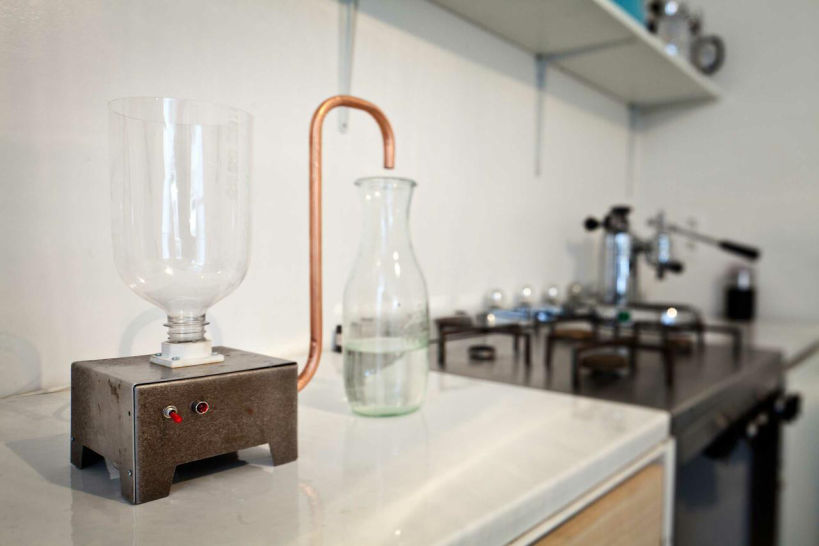
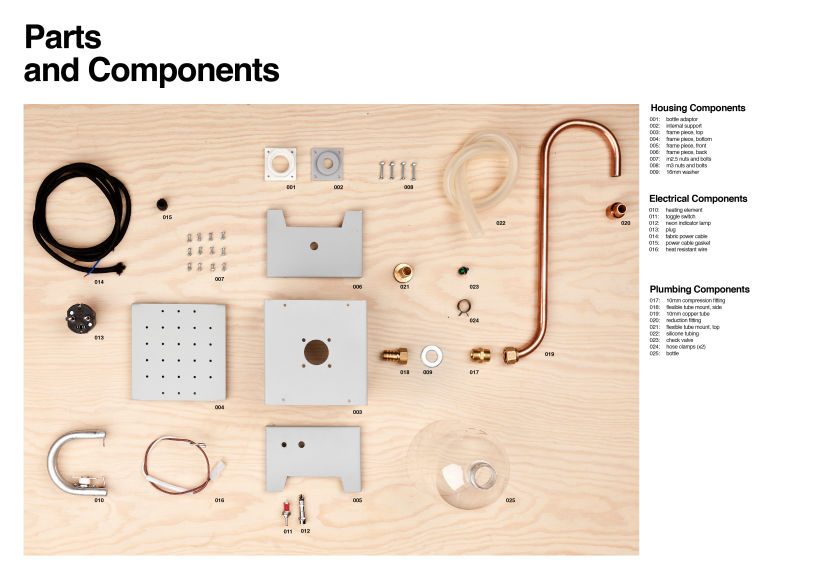
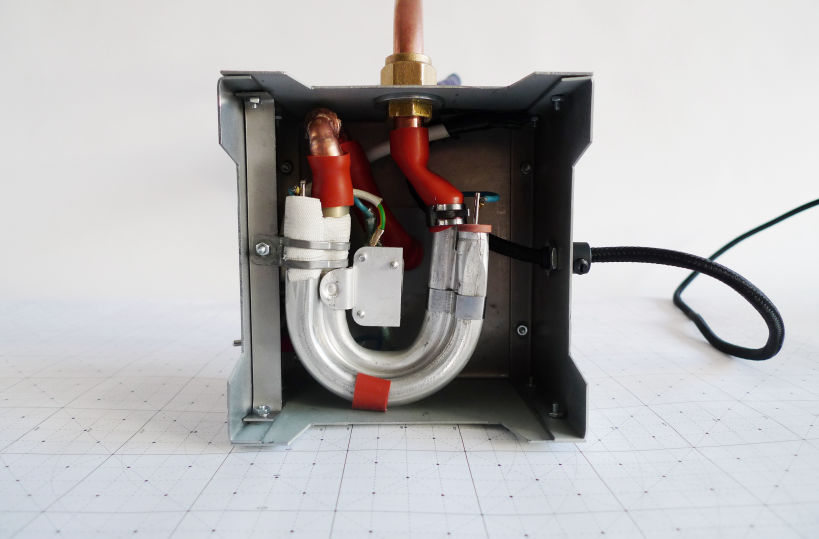
All three objects are designed by Jesse Howard, in collaboration with Thomas Lommée, and all share a common logic and are part of the larger OpenStructures project in which Lommée and his collaborators are engaged. This project and its offsprings/spinoffs constitute the main case studies of this chapter, primarily due to their unfamiliar appearances, but essentially because of their unconventional designing process. As reminded in the previous chapter, beneath their shiny appearance, commodities mask the social relations in their creation. Would it be possible for product design beyond the commodity-machine to do the opposite, that is, to reveal, to render legible the labour conditions of the design within the materiality of the objects themselves? OpenStructures, through its reliance on open standards and distributed modularity, is highly illustrative due to the strong correlation it presents between its physical features and the organisation of its development. In this section, I explore how and why this project became a symbolic early example of the rejuvenated interest in values that were lost with the throw-away consumerism induced by global commodity flows of recent decades. That said, rather than treating my case studies as examples of DIY or participatory design, as defined in the previous section, I consider them to be rather attempts to adapt peer-production principles to design, and in doing so, they constitute interventions that negotiate the modalities of design labour away from market-based practices, and towards commons-based forms of value production. They may not instantly abolish the categories of designer, maker and user, although they do manifest a new kind of designer – one that is less concerned with occupying the privileged position between the manufacturer and user, and more interested in redesigning the modalities of design labour itself.
The OpenStructures project was introduced with a simple yet ambitious formula: “everyone designs for everyone” (OS, About), which can be understood to be in direct contrast to the solitude of Do-It-Yourself and its libertarian or individualist connotations, In short, this is a project that is meant to bring people together on a common ground. In order to facilitate the mutual design process, “Common design guidelines” provide some “rules of thumb” that are worked out in advance (OS, Guidelines).[1] The first principle is to design for disassembly, in which no glue, tape or nails are allowed so that the structural integrity of every component is maintained, and by extension, repairs, upgrades and hacks are encouraged. The second principle is to opt, whenever possible, for infinitely recyclable materials so that the pieces can be reborn as a resource when no longer serving as components. These two principles are common to other design standards, such as Cradle2Cradle. What sets OpenStructures apart is the third principle – the OS Grid, consisting of 4x4cm squares as the basis of a 60x60cm OS Ruler. The grid and the ruler impose dimensions, assembly points and diameters that are meant to make every part, component, or structure compatible with each other —a common denominator for things, or, as it is often suggested, a Meccano or Lego kit for useful objects. Collaboration can be a principle to strive towards, or can be integrated into the project by design. OpenStructures intends the latter approach -- like an open jigsaw puzzle, pieces created by anyone can fit into anybody else’s composition. If circular principles like Cradle2Cradle are for materials, and second-hand circuits are for entire objects, OpenStructures enables and encourages the circulation of components of modular systems that “should generate objects of which it is not entirely clear anymore who designed them” (De Decker). Each part, component, or structure is documented and indexed in an online database —a Library of Babel for things.
At first sight, this level of standardisation may seem to imply severe restrictions and rigid rules, and to be at odds with the values of freedom and autonomy associated with DIY.[2] Embracing open standards and interoperability, however, can be beneficial in efforts to counter the fragmentation and incompatibility of self-made, and therefore unique, components. This principle is, after all, also at the core of networked technologies – without telecommunication standards, the Internet would simply not exist. It is no coincidence that peer production first became apparent and effective in software development. The immateriality of software provided the ideal conditions for the development of successful examples of peer production, where Internet-based collaboration requires little investment other than labour time and already-existing hardware, thus facilitating the contributions of others. The organisation of software and hardware design along the lines of P2P principles can be comparable to the valorisation of creativity and knowledge production. However, it has been extensively debated whether the methods of software development can be as successful in the domain of product design, where upfront costs and investment imperatives are unavoidable. After all, without raw materials, shaping moulds or physical prototypes, not many products can be designed. Still, OpenStructures follows the models initiated in software, with the intention being to adapt them to physical objects. It does this by encouraging modularity of design and the self-appointment of tasks, and arranges collaborations in autonomous temporalities (as opposed to real-time collaborations). Modularity is the key to countering the division of labour, and subsequently, to lowering the threshold for participation. Smaller sub-projects are more manageable than vast design problems, and subdivisions and components are useful for the distribution of tasks in a project, each having autonomy in their respective roles. However it is yet to be determined if the supply of free creativity can match the demand of specific development tasks, or in other words, if the tension between the holistic solutions to design problems and modular contributions to distributed development can be resolved. Lommée expresses a clear preference for the latter approach:
Lommée encourages the new generation of designers to both cultivate humble approaches to define their own roles, and to search together for ever bigger, collective goals. Global collaborative projects like Wikipedia or Linux are, according to Lommée, “challenging —and outperforming— the individual achievements of some of our brightest, leaving us with no other choice than to acknowledge the limits of our individual projects and participate in these larger collusive processes“ ('OpenStructures' 68). In comparison to taking part in such grand projects, the lone designer figure of the present appears old-fashioned and outdated, as the genius inventor of early industrial innovations. The underlying assumption is that a single designer (or alternatively, a design studio with a hundred workers) that secretly develops closed and “finished” objects from scratch cannot compete with globally connected, swarming creativity that relentlessly improves and diversifies the outcome? OpenStructures responds to the latest developments in network technologies as well as maker cultures by presenting itself as research in modularity, meant “to rethink its potential within a network context —because we live in a network context” (Lommée, interview). Ultimately, modularity is not sought as a functionalist end-goal in terms of how objects interact, but as a means of coming up with more collaborative design principles, based on how designers interact. Instead of one designer proposing a closed system of objects with many uses, OpenStructures brings together many designers into an open system each time for the development of a single-use object. In this way, the objects mirror their development, in that it is through modularised design work that modular designs emerge. This is equally valid at the opposite end of the spectrum, as when products are designed in-house with the highest level of secrecy, as exemplified by Apple (Julier, Object 479), the resulting objects are as integrated and sealed off as the company itself. Design products themselves can thus become legible from an analysis of the organisation of their design labour. That said, things are rarely designed once and for all, as designs are subject to transformations over time, and even more so if they are open-ended, modular and collaborative projects. In the next section, I explore how modifications and reappropriations are negotiated among “designer-collaborators”, or peer designers.
[1] As the main source of information for OpenStructures (as well as later case studies) is their online presence, most references are given without page numbers.
[2] It may also indicate as a very designerly expression of an obsessive-compulsive behaviour; see the neat arrangement of components over the grid.
The OS Boiler and Transparent Tools were only part of the initial batch of home appliances that Jesse Howard worked on. In 2014, he led a group of designers, hackers and makers that responded to a callout to develop “Hacking Households” as part of the Biennial of Design in Ljubljana. After a 3-day kick-off gathering where Thomas Lommée presented the OpenStructures project, they continued collaborating via online brainstorming tools, and met a few times to accelerate the process, only six months before the exhibition opening. The project resulted in a collection of fans and a mixer, all built around a rotational motor, thus sharing a common logic and interchangeable components. At the time of the exhibition, the basic fan was functional, including its electronic components, while the heater and mixer remained in the early prototype stages due to time constraints. The video accompanying the project features stop-motion animated components that change dimensions according to given parameters, and in which objects seem to self-assemble without any human agency. [fig. 8] In fact, the only human intervention depicted is a hand switching on the fan, first with a button and then via a smartphone. A voice-over calmly explains the process, with additional text overlays that to provide emphasis:
A recombination of components, generative structures, an ecosystem of open products – this is the set of promises made by OpenStructures. Then what exactly sets this project apart? After all, it seems to comply with the 1rules of thumb1 of disassembly, recyclability, and to a certain extent, grid compatibility. Yet there is no mention of OpenStructures as an inspiration, nor are the designs available on the database. Does this implicit “declaration of independence” reveal the limits of collaborative design principles? This fragmentation of open-modular systems may appear to be a failure to engage designers in production for the platform, especially for OpenStructure, which claims to be “the most diverse modular system in the world” (qtd. in King). However, instead of seeking strictly active collaboration and collective decision making, it can also be seen as a respectful distance between likeminded yet autonomous projects that contribute to a larger common pool of knowledge. Here we encounter a principle that has clearly been adopted from software development: “forking”, referring to the proposal of a derivative that retains aspects of an open project while developing other aspects further, without necessarily claiming to be the definitive progression of the original. Howard gives several reasons for choosing a forking approach. While the Hacking Households team are familiar with and sympathetic to the OpenStructures principles, the exploration of parametric processes was prioritised over the finalisation of definitive objects, and since then, their investigation has shifted towards logistics and economics, or in Howard’s words, “designing the system in a way that bridges the design world to the maker world”, where such objects can be developed further. Lommée equally shares such concerns, and there would seem to be space for cross-pollination, increasing the chance of generating diverse strategies.
The results of such mutual inspirations are apparent in the more recent video introducing the OpenStructures project. [fig. 9] Similar to the Hacking Households video, it also features a stop-motion animation of objects over a blank background, but without a voiceover. It begins with an object entering the spotlight to applause and a drum roll – a Lamp Shade, designed by Marianne Cardon (FR), prototyped at FabLab Brussels (BE) and produced through vacuum forming. The Lamp Shade hops onto a perforated panel, held together by a shelf pin, a wooden stick, a rivet and a screw, all of which are found to be compatible with the holes that match the OS grid specifications. The Lamp Shade then whirls around and doubles itself, meets a wooden baseplate and a laser-cut half metal arrow to become a Bedside Lamp, “configured by” Marianne Cardon and containing OS parts by Pia Jacques. The next adventure of the Lamp Shade develops together with the evolution of the 3D printed Clip 1.0, designed by Maxime Loiseau. The lamp first reveals Clip 1.1, edited by Florian Bédé, and made through additive manufacturing, and then Clip 1.2 by Marianne Cardon, made through a sintering technique. The duo is joined by a handcrafted marble baseplate designed by Christiane Hoegner, and then assembled with a standard wooden stick and custom ball joint plates to become a Desklamp “configured by” Thomas Lommée. In the third, comical act, all of the previous components make a final apparition, accompanied by a tube scaffolding and a car clip. They gather on top of the OS grid, extending to the horizon, and attempt to self-assemble once more, this time becoming a dysfunctional composition that quickly comes apart, to the amusement of the invisible audience. They neatly fall into place over the grid, and the tagline is spoken –each word by a different voice: “OpenStructures: It all works together or it doesn’t work at all.” Instead of a chorus chanting in absolute harmony, this rendering of a collaboration does not seek perfectly coordinated efforts; but rather endorses individuality to the point of embracing dissonance.
It is not only the objects that seem to be animated with intent, as their designs also have a life of their own. Each successive generation is placed on an evolutionary tree, carrying forward a genetic inheritance that is either expressed in mathematical formulae or complemented with version numbers, bringing product design all at once closer to biological structures, as well as to the programming language. Interest in generative and interchangeable systems comes not only from technical reasoning, it also expresses a sensibility to ecological systems. For the OpenStructures project, the ecological parallels are made explicit in the “structural buildup” of different scales. [fig. 10]
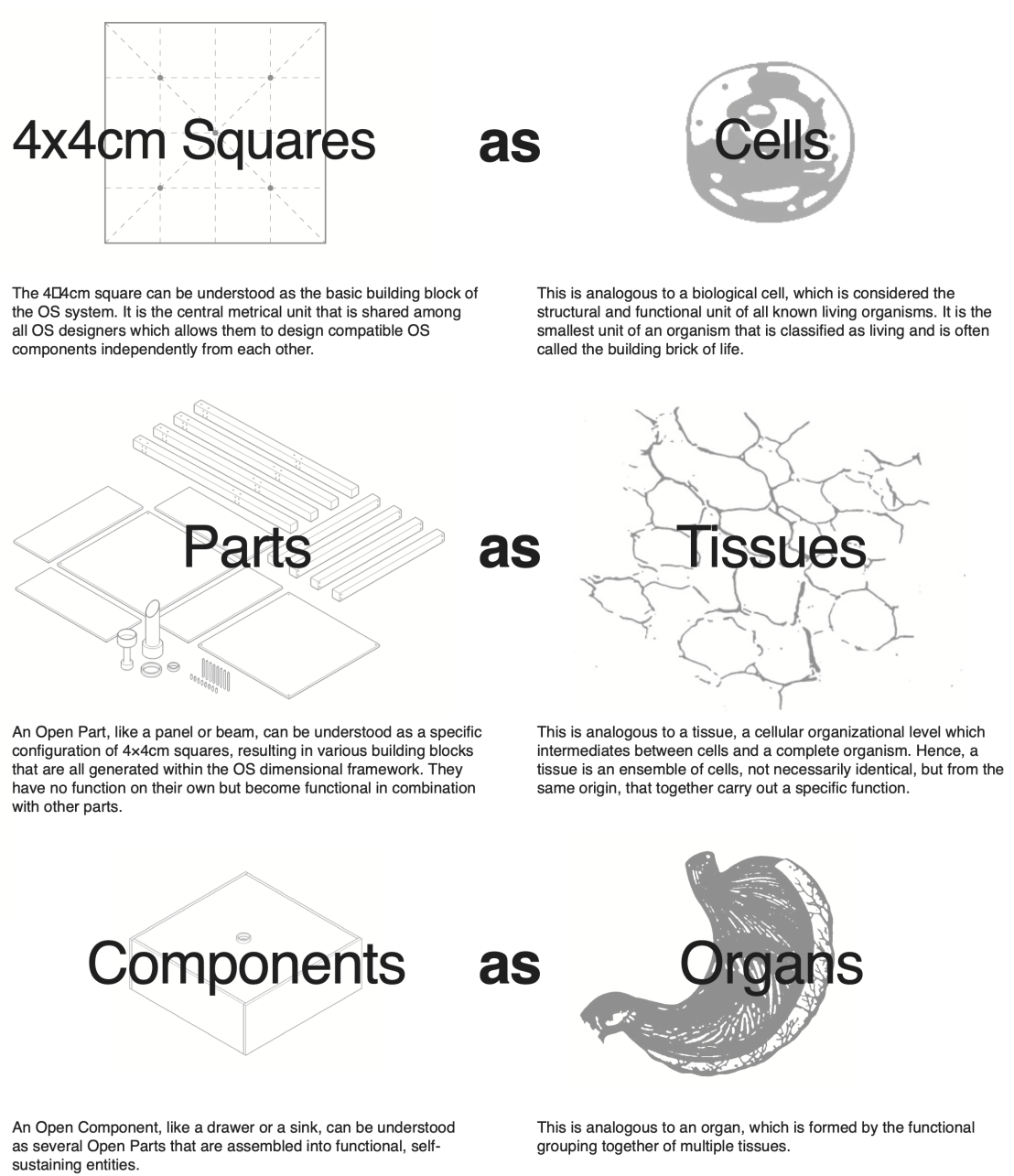
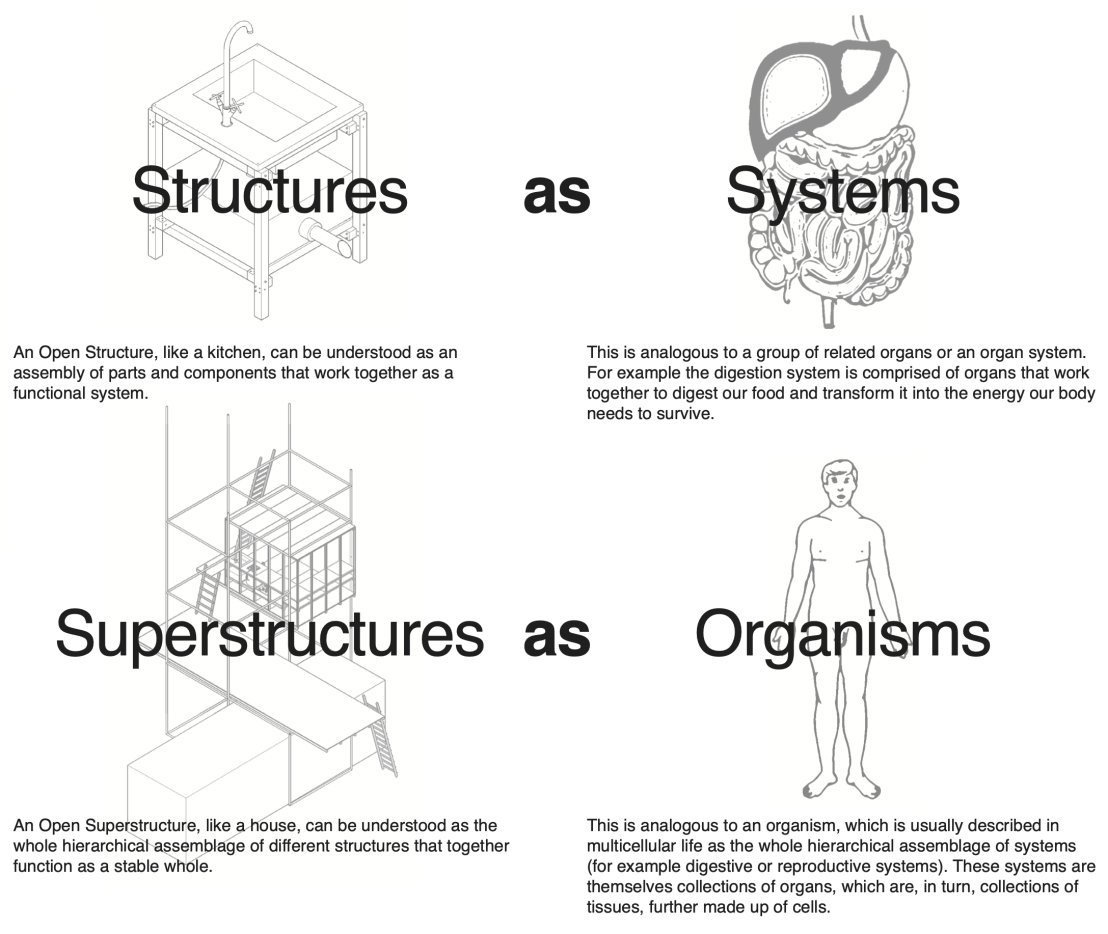
Borrowing from biology, the 4 cm by 4 cm squares are proposed as equivalent to cells, the parts (panels or beams) correspond to tissue, the components (such as drawers) to organs, the structures (kitchen or bathroom) to systems (respiratory or digestive) and the superstructures (like a house) to organisms. This echoes the long-standing influence of biomimicry in design, the interest in growth patterns and the fascination with scales that date back to the Arts and Crafts movement, to metabolist architecture, or to the 1977 documentary film “Powers of Ten” by designers Charles and Ray Eames. What is novel is that open modularity offers a compelling imitation of evolutive mechanisms. “It adds the dimension of time” to design processes that are otherwise marked by a few sudden jumps and plenty of dead-ends (Lommée, Open Modular Systems). Contributors to a project do not collaborate in real-time, but rather build upon the previous works of others. Instead of conceiving objects from scratch, “they are upgrading, restoring and adding layers to an existing tissue” ('OpenStructures' 69), and knowledge gets transferred and accumulated over time. For Lommée, this has far deeper social implications:
To see an object as a modest update to a collective effort instead of a proud achievement of an individual is not an insignificant request in a professional culture that is dominated by designer-brands, in a consumer culture where every new product is “revolutionary”, and in a civilisation where the cult of the author as a solitary genius has been established ever since the Renaissance (Stillinger). Questions of authorship have become even more ambiguous in the context of firms that employ, control and own the creative labour of hundreds of designers under the banner of a single starchitect (Picon). After all, authorship and authority are not only related etymologically, as creative production grants makers exclusive rights over what can be done with that work in terms of ownership, circulation and modification. In this context, the absence of humans (designers, manufacturers and even users) from the assembly process in favour of objects and components “coming alive” is striking, although stop motion animation has become a recurrent strategy employed in such presentation videos. Several reasons for this can be put forward. First, downplaying the designer makes sense, considering the fact that there is no individual designer to which the object can be attributed, hence the credit is given not for designing, but for “configuring”. The same kind of shift in roles may be true also for the manufacturers, since they are supposedly supplanted by digital fabrication tools, with manual labour becoming redundant as they are subsequently reduced to the role of machine operators. Finally, the users of such objects can no longer be signified by the passive consumer stereotypes, but by more ambiguous subjectivities. What remains is, therefore, the objects themselves, in an aesthetic treatment that is not exactly one of commodity fetishism, and yet still expressing a relationship between things that exceeds their use-value. In the following section I will subject the case study to theoretical debates on the potentials and pitfalls of peer production, and investigate what values are produced or embodied in such projects.
The goal of this chapter was to identify the organisational forms under which design practices lead to commoning, in which the current conditions of designers were theorised from a labour perspective, and to discuss the shifting approaches to design. A value-based analysis of design labour enabled me to see beyond the definitions of the latest trends and to visualise the broader dynamics. Designers are subject to either hierarchical or competitive working environments that conflict with design principles and ethics, and while there are increased opportunities for cooperation between designers, manufacturers, users and other stakeholders, collaborations between freely associated designers are not exactly widespread. While peer-to-peer theory has been an appropriate framework for the identification and examination of the commons-based valorisation of design labour, several critical challenges have been identified to the successful adaptation of these principles to product design. I put forward OpenStructures as a prime example of peer-to-peer principles applied and adapted to product design. This case study offers suggestions of how to overcome these difficulties through the introduction of open standards, distributed modularity and the forking of contributions. It hints at how designer-to-designer collaborations can be encouraged, organised and valorised, and testifies how peer-produced objects can reveal the organisation of their design labour, unlike the masking of social relations on the surface of commodities. What sets OpenStructures apart is the role of the designers, which cannot be explained entirely within the field of DIY or maker cultures, as they should instead be considered as designer-commoner subjectivities. This is why I conclude this chapter with an interview with Lommée, the initiator of OpenStructures. In listening to a designer-commoner subjectivity, my intention is not to take their words about their practice for granted, but to question the intentions, considerations and positions of this emergent subject. This will contribute to mapping where OpenStructures succeeds and fails, and the limitations of peer designing.
Thomas Lommée expresses his belief that “it is not the object that needs to be redesigned (...), but it is actually systems that produce the objects that need to be rethought” (interview). In other words, a designer must first redesign him/herself before designing anything else, since the designer is also part of that system. Such an open invitation with existential implications can be a catalyser as much as a paralyser. In a system where everything from the smallest component to the largest superstructure is to be redesigned for everyone, where does one begin? Indeed, without concrete goals as part of a more extended project “roadmap”, there is the risk of spreading the attention too thin over several fields or objects at the same time. When questioned about this lack of direction, Lommée states that he is aware of it, and claims that his approach is to leave it radically open intentionally for the first 6–7 years, and to experiment without limitations, regardless of whether it leads to successes or failures. Some patterns eventually emerge, with scaffolding systems, bikes and other small vehicles being the most promising fields so far. The other case studies addressed in the following chapters all have a much narrower focus in the development of a single item, and yet they remain an open-ended process that is still open to improvements and diversifications of the object. Lommée, however, prefers to approach his design project as a question rather than an answer, because “it allows you to try things out, and perhaps fail” (interview). As is the case with scientific inquiry, individual failure is no longer a failure if it generates collective learning, a common sense, and this apparent modesty has to be one of the qualities that sets OpenStructures apart. Lommée even confesses, “It is true that some things that I made don’t work, it’s really absurd” (interview). When asked if this is why OpenStructures was dubbed an “Esperanto of objects” by Domus Magazine – an admirable and beautiful idea of a common language that never fully materialised, he responds that almost all open projects have this limitation in common. Just like a language, OpenStructure is meant as an infinitely generative system in which designers and their designs understand and reconfigure each other.
There have been other modular and self-assembled systems, including such significant antecedents as the works of Ken Isaacs as well as Enzo Mari’s Autoprogettazione, both from the 1970s. These were groundbreaking projects that countered industrial production by encouraging users to become producers. While such projects left their mark on design history, their impact remained limited, if not overwhelmed by globalised commodity flows. They were, after all, developed by a single designer and destined to individualised self-production, mass participation in design processes not yet being an option. It could be argued that modularity has been somewhat of a holy grail of industrial design, with everything fitting perfectly together, derived from a common language, leaving great freedom for adaptation according to needs and desires. Can OpenStructures succeed where previous projects have failed? Can it deliver anything unprecedented? There are two contradictory signals that can be traced in the language employed to describe the purpose of the project. To begin with, the project declares a maximalist “ultimate goal” that includes everyone and everything all at once: “to initiate a universal, collaborative puzzle that allows the broadest range of people —from craftsmen to multinationals— to design, build and exchange the broadest range of modular components, resulting in a more flexible and scalable built environment” (OS, About). Since the first time the modernist project was contested (and subsequently abandoned), no designer has dared to formulate an agenda in the manner of the early industrial design manifestos of universalism, broad adoption and harmony reestablished. The OpenStructures slogan “it all works together or it doesn’t work at all” also expresses such grand all-or-nothing ambitions, an ambiguity in line with the postcapitalist project of redesigning everything. On the other hand, this attitude is nonetheless counterbalanced by the careful wording of a cautious and modest research programme. The project is defined on its website as an experiment that “tries to find out what happens if” an open modular system is adopted, and “what the opportunities and limitations” are, “and under which conditions it will prove to be most efficient and favourable” (OS, About). Similarly, when questioned about his ambitions, instead of proselytising the superiority of open modular systems in order to impose them on everyone, Lommée insists his aim is not to make everything modular. He expresses his wish being to reach to only 1% of designers and makers, which would be for him already an exceptionally diverse and valuable system. The paradox between offering infinite adaptability while avoiding the mainstream is best captured in Lommée’s prediction that “The next big thing will be a lot of small things” (Small) – which was a slogan that was immortalised in a mural at the University of Ghent. Perhaps this can be read as a multiplicity of smaller commons replacing one big commodity-machine.
It is in the same spirit that Lommée qualifies his design studio as “pragmatic utopian” (an oxymoron used also by the architect Bjarke Ingels). This is a fitting description for a designer-commoner: while new opportunities and cultures may be emerging, there is no indication of a complete overhaul of the economic system yet in sight —the challenge is then to negotiate a prefigurative pragmatism with a sense of speculative utopianism. Lommée states in no uncertain terms that he does not believe one system will replace the other, claiming “sometimes the commons will do a better job, other times the classical systems will prevail” ('Esperanto'). This lack of a clear-cut directionality leads Lommée, among others, to endorse and navigate both worlds, expecting that in all likelihood market and commons-based regimes will most likely cohabit. It would seem likely that where the two models overlap and result in hybrid forms, economic mutants with both proprietary and collective characteristics will emerge. This ambivalent stance is indicative of the generalised “identity crisis” that many similar projects experience when they confront the reality of the economy and are dominated by the disciplinary power of the market. While recognising that “the open-source hardware movement is based on a desire to create new economies of production” (qtd. in King), Lommée also celebrates the marketplace as the “ultimate forum” (OS, About). At the same time, he affirms that “OS is not something that can be marketed — the moment you market it, it starts to self-destroy” (qtd. in Sacchetti). He is careful to distinguish between “open modularity” and “open-source”, suggesting that the modular system is open to anyone to add components, although the existing components may not necessarily be open-sourced themselves. He is not against the intellectual protection of some components, mainly due to the upfront investment costs that are necessary for their development. Lommée questions, however, “what happens if a garage maker open-sources something and a big company downloads it and has the means to pay for that mould, and they get even richer with your idea?” (interview). Just like a commoner, he distinguishes between sharing with other commoners for mutual benefit and allowing a free-riding capitalist to steal his labour. This dilemma will be addressed in the next chapter with specific terms of licensing, although it is already apparent that just like any other commons, modalities of inclusivity and access depend on the contribution of participants, protecting the commons against simply “giving away” to free-riders.
This carefully welcoming attitude towards collaboration strikes me as a refreshing stance when compared to how creative workers are usually portrayed. They are presented either as a daring entrepreneurs in cut-throat competition, or a self-exploited and isolated victim of precarity (De Peuter and S. Cohen, in Oakley and O’Connor 305). Instead, it is with attentiveness to the community that the designer-commoner transcends individualism, however deeply engrained that might be. One part of that effort necessitates being able to attract and retain peer producers to the project in the first place, which is a constant challenge for Lommée: “I also have a responsibility towards the users, because otherwise they just go to another forum. I have to make this platform the most successful, the most attractive, open, transparent vehicle, if not, I won’t have a community” (interview). In that sense, the community becomes the ultimate asset, or the infrastructure that sustains all the activities, and there needs to be a continuous flow of reasons and benefits for coming back, to keep contributing and bringing in new collaborators. If one challenge is to broaden the base, the other effort is to maintain consistency and harmony within the community. In another interview, Lommée insists that “the use of OS should derive from a shared mindset (...), its users should understand the value of OS and share this kind of common value, or believe in the sense of doing and designing things in such a way” (qtd. in Sacchetti). The normative tone and the insistence on a common understanding and shared values may appear dubious, especially for a system that prides itself in its diversity and modularity. Still, not unlike the grid itself, a coherent social code is necessary to make the openness regenerative and sustainable. What remains undefined is whose values are to be prioritised, and how will the community get to modify and modulate them. There is no indication that the sense of community around such a distributed, modular system would ever evolve into a lasting and reliable cooperative endeavour. That said, there are plenty of reasons why creative labourers would institute worker cooperatives that provide livelihoods, autonomy, solidarity and community all at once, while contributing to cultural commons at large (Sandoval 67).
Throughout this survey of designers as immaterial workers, co-creators and peer producers, I have determined several preconditions for the actualisation of their latent commoner potentials. Firstly, peer-designers need to be able to sustain themselves and maintain viable livelihoods if they are to engage in alternative value practices. Secondly, the establishment of open design cooperatives based on the free association of peer-designers appears to be essential for the reproduction of commoner subjectivities. Thirdly, the success or failure of such commons-producing design communities depends on their capacity to claim an autonomous sphere for the valorisation of their labour. Ultimately, if these institutions of collective action are to tackle collective design problems and co-design an exit from capitalism, an alignment of individual, collective and social goals needs to take place. The analysis of design artefacts and discourses from a labour perspective revealed remarkable developments in the networked, cooperative labour relations that exist among designers and in the reproduction of designer-commoner subjectivities. While they remain entangled with the commodity-machine, to a certain extent, their latent potentials could still be made legible through the lens of commoning. These case studies inhabit both temporalities simultaneously, and constitute the first instance of postcapitalist design practices in this study. Where the journey of a designer subject ends, the autonomous journey of a design project begins. In the next chapter, I investigate how commoning occurs in the circulation of open-source design projects.
Start your own web page with Mobirise